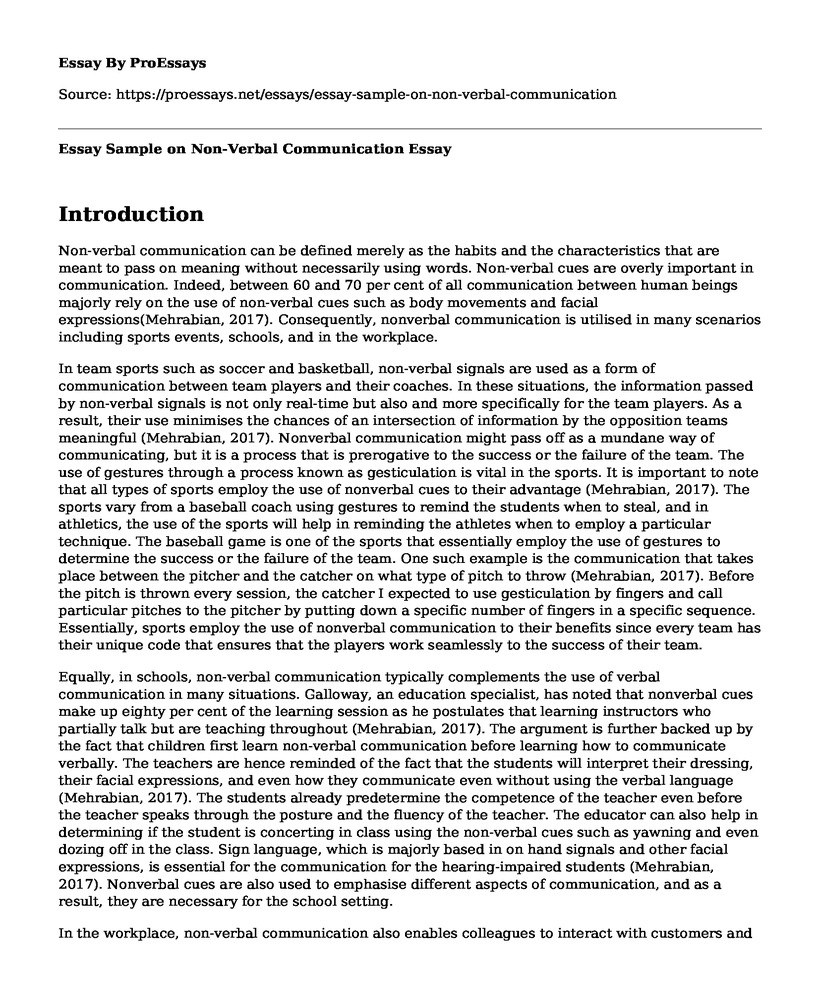Introduction
Non-verbal communication can be defined merely as the habits and the characteristics that are meant to pass on meaning without necessarily using words. Non-verbal cues are overly important in communication. Indeed, between 60 and 70 per cent of all communication between human beings majorly rely on the use of non-verbal cues such as body movements and facial expressions(Mehrabian, 2017). Consequently, nonverbal communication is utilised in many scenarios including sports events, schools, and in the workplace.
In team sports such as soccer and basketball, non-verbal signals are used as a form of communication between team players and their coaches. In these situations, the information passed by non-verbal signals is not only real-time but also and more specifically for the team players. As a result, their use minimises the chances of an intersection of information by the opposition teams meaningful (Mehrabian, 2017). Nonverbal communication might pass off as a mundane way of communicating, but it is a process that is prerogative to the success or the failure of the team. The use of gestures through a process known as gesticulation is vital in the sports. It is important to note that all types of sports employ the use of nonverbal cues to their advantage (Mehrabian, 2017). The sports vary from a baseball coach using gestures to remind the students when to steal, and in athletics, the use of the sports will help in reminding the athletes when to employ a particular technique. The baseball game is one of the sports that essentially employ the use of gestures to determine the success or the failure of the team. One such example is the communication that takes place between the pitcher and the catcher on what type of pitch to throw (Mehrabian, 2017). Before the pitch is thrown every session, the catcher I expected to use gesticulation by fingers and call particular pitches to the pitcher by putting down a specific number of fingers in a specific sequence. Essentially, sports employ the use of nonverbal communication to their benefits since every team has their unique code that ensures that the players work seamlessly to the success of their team.
Equally, in schools, non-verbal communication typically complements the use of verbal communication in many situations. Galloway, an education specialist, has noted that nonverbal cues make up eighty per cent of the learning session as he postulates that learning instructors who partially talk but are teaching throughout (Mehrabian, 2017). The argument is further backed up by the fact that children first learn non-verbal communication before learning how to communicate verbally. The teachers are hence reminded of the fact that the students will interpret their dressing, their facial expressions, and even how they communicate even without using the verbal language (Mehrabian, 2017). The students already predetermine the competence of the teacher even before the teacher speaks through the posture and the fluency of the teacher. The educator can also help in determining if the student is concerting in class using the non-verbal cues such as yawning and even dozing off in the class. Sign language, which is majorly based in on hand signals and other facial expressions, is essential for the communication for the hearing-impaired students (Mehrabian, 2017). Nonverbal cues are also used to emphasise different aspects of communication, and as a result, they are necessary for the school setting.
In the workplace, non-verbal communication also enables colleagues to interact with customers and colleagues effectively by complimenting oral information. Non-verbal communication will go a long way in helping the quality managers to review the feedback from the customers and the working standards of the employees (Mehrabian, 2017). The posture, the facial expressions are all critical in maintaining the standard of the company if they are interpreted accordingly. Besides, non-verbal cues will help in motivating the staff if they feel acknowledged and appreciated above the usual verbal compliments,
Using non-verbal communication in these situations has many advantages. First, non-verbal cues complement messages, thus making them more meaningful (Mehrabian, 2017). They also improve the ease of presenting information during communication. In cases where obstructions such as noise are prevalent, non-verbal cues of communication help to substitute information.
On the other hand, non-verbal communication may be ineffective because it may sometimes be imprecise and vague. The lack of organisation and structure makes it easy to change the meaning and context of information. It is also easy to miss cues if attention is not optimally paid. Despite this flaws, however, non-verbal communication is essential for many contexts of communication meaningful (Mehrabian, 2017).
References
Mehrabian, A. (2017). Nonverbal Communication 1st Edition, Kindle Edition by Albert Mehrabian (1st ed.).
Cite this page
Essay Sample on Non-Verbal Communication. (2022, Jul 15). Retrieved from https://proessays.net/essays/essay-sample-on-non-verbal-communication
If you are the original author of this essay and no longer wish to have it published on the ProEssays website, please click below to request its removal:
- Non-Verbal Communication
- Sociology Essay Example - Gender Stereotypes and Culture
- How Social Movement, Women's Movement, and the Civil Rights Movement Affect Democracy
- The Importance of Groups to Christian Leadership Essay
- Essay Sample on Ethnicity and Racism in Canada
- Essay Example on Exploring Positive Youth Justice: Assessing Claims of Uniqueness and Robustness
- Paper Example on Exploring China's Hidden Rural Treasures: A Homestay Adventure







